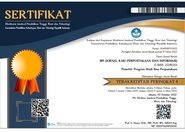EXPLORING THE MULTIGENERATIONAL INFORMATION LITERACY GAP IN DIGITAL SOCIETY
Abstract
Keywords
Full Text:
PDFReferences
Ackerman, M. S. (2000). The intellectual challenge of CSCW: the gap between social requirements and technical feasibility. Human–Computer Interaction, 15(2–3), 179–203.
ACRL. (2016, January 11). Framework for Information Literacy for Higher Education. Association of College and Research Libraries. https://www.ala.org/acrl/standards/ilframework
Afzal, A., Khan, S., Daud, S., Ahmad, Z., & Butt, A. (2023). Addressing the digital divide: Access and use of technology in education. Journal of Social Sciences Review, 3(2), 883–895.
Afzal, N. (2019). A study on vocabulary-learning problems encountered by BA English majors at the university level of education. Arab World English Journal (AWEJ) Volume, 10.
Badan Pusat Statistik. (2022). Indeks Pembangunan Teknologi Informasi dan Komunikasi (IP-TIK) 2022. BPS RI. https://www.bps.go.id/publication.html
Botelho, F. H. F. (2021). Accessibility to digital technology: Virtual barriers, real opportunities. Assistive Technology, 33(sup1), 27–34.
Braun, V., & Clarke, V. (2006). Using thematic analysis in psychology. Qualitative Research in Psychology, 3(2), 77–101. https://doi.org/10.1191/1478088706qp063oa
Braun, V., & Clarke, V. (2019). Reflecting on reflexive thematic analysis. Qualitative Research in Sport, Exercise and Health, 11(4), 589–597.
Choudhary, R., Shaik, Y. A., Yadav, P., & Rashid, A. (2024). Generational differences in technology behavior: A systematic literature review. Journal of Infrastructure, Policy and Development, 8(9), 6755.
Colasante, T., Lin, L., De France, K., & Hollenstein, T. (2022). Any time and place? Digital emotional support for digital natives. American Psychologist, 77(2), 186.
Creswell, J. W., & Creswell, J. D. (2018). Research Design: Qualitative, Quantitative, and Mixed Methods Approaches (5th Editio). SAGE Publications.
Dumitru, E.-A., Ivan, L., & Loos, E. (2022). A generational approach to fight fake news: In search of effective media literacy training and interventions. International Conference on Human-Computer Interaction, 291–310.
Global Education Monitoring Report Team. (2023). Global Education Monitoring Report 2023: Technology in education: A tool on whose terms? GEM Report UNESCO. https://doi.org/10.54676/UZQV8501
Gumati, M. R. (2024). Digital Sovereignty and State Power: Indonesia’s Approach to Digital Platforms Regulation. JISPO Jurnal Ilmu Sosial Dan Ilmu Politik, 14(1), 99–126.
Helsper, E. (2021). The digital disconnect: The social causes and consequences of digital inequalities.
Helsper, E. J., & Van Deursen, A. J. A. M. (2017). Do the rich get digitally richer? Quantity and quality of support for digital engagement. Information, Communication & Society, 20(5), 700–714.
Irwanto, I., Bahfiarti, T., Unde, A. A., & Sonni, A. F. (2025). Information disorder’s impact on adolescents: publication trends and recommendations. Frontiers in Communication, 10, 1495536.
Islam, M. A., & Bhuiyan, M. R. I. (2022). Digital transformation and society. Available at SSRN 4604376.
Jati, W. R. (2024). From Millennial to Generation Z: The State of Digital Literacy among Youths Dealing with Disinformation During Elections. Jurnal Komunikasi Indonesia, 13(1), 19.
Kuputri, N. M. (2020). Digital Divide: A Critical Approach to Digital Literacy in ‘Making Indonesia 4.0.’ The 2nd Tarumanagara International Conference on the Applications of Social Sciences and Humanities (TICASH 2020), 1–6.
Livingstone, S., & Helsper, E. (2007). Gradations in digital inclusion: Children, young people and the digital divide. New Media & Society, 9(4), 671–696.
Lombardi, M. (2023). Digital economy and digital divide. In Global handbook of inequality (pp. 1–27). Springer.
Magliocca, P., Faggioni, F., Muto, V., & Caputo, F. (2024). Technology readiness and digital gap for depicting socio-economic dynamics in society 5.0: a meso-level observation. The Journal of Technology Transfer, 1–17.
Mergel, I., Edelmann, N., & Haug, N. (2019). Defining digital transformation: Results from expert interviews. Government Information Quarterly, 36(4), 101385.
Millard, J. (2023). Impact of digital transformation on public governance. European Union, Luxemburg.
Mubarak, F., & Suomi, R. (2022). Elderly forgotten? Digital exclusion in the information age and the rising grey digital divide. INQUIRY: The Journal of Health Care Organization, Provision, and Financing, 59, 00469580221096272.
Nawaf, A., Azura, S., Gultom, S. F., Afriansyah, W., & Putra, A. D. (2023). Analisis literasi digital dalam penggunaan media sosial di kalangan remaja Desa Payung Kec. Payung Kab. Karo. Journal Of Human And Education (JAHE), 3(2), 337–343.
Nawaz, I. Y. (2020). Characteristics of millennials and technology adoption in the digital age. In Handbook of research on innovations in technology and marketing for the connected consumer (pp. 241–262). IGI Global Scientific Publishing.
Oh, S. S., Kim, K.-A., Kim, M., Oh, J., Chu, S. H., & Choi, J. (2021). Measurement of digital literacy among older adults: systematic review. Journal of Medical Internet Research, 23(2), e26145.
Park, H., Kim, H. S., & Park, H. W. (2021). A scientometric study of digital literacy, ICT literacy, information literacy, and media literacy. J. Data Inf. Sci., 6(2), 116–138.
Robinson, L., Schulz, J., Dunn, H. S., Casilli, A. A., Tubaro, P., Carvath, R., Chen, W., Wiest, J. B., Dodel, M., & Stern, M. J. (2020). Digital inequalities 3.0: Emergent inequalities in the information age. First Monday, 25(7).
Spaticchia, U. (2024). Generational Transformations and Digital Media: continuity and change. Addiction & Social Media Communication, 1(2).
Strauss, W., & Howe, N. (1991). Generations: The history of America’s future, 1584 to 2069. William Morrow and Company. Inc., New York.
Sugeng, S., Fitria, A., & Rohman, A. N. R. A. N. (2022). Promoting digital literacy for the prevention of risk behavior in social media for adolescents. Jurnal Keamanan Nasional, 8(1).
Taylor, N. G., & Jaeger, P. T. (2021). Foundations of information literacy. American Library Association.
Van Dijk, J. (2020). The Digital Divide. Cambridge: Polity Press. Communication, 2020.
Wandhe, D. P. (2024). The new generation: Understanding millennials and Gen Z. Available at SSRN 4716585.
Windarsari, W. R. (2025). Teenagers’ Interest In Property Ownership In Digital Age. Management, Economics, Trade, and Accounting Journal (META-JOURNAL), 2(4), 139–144.
Yunitasari, Y., & Prasetya, H. (2022). Literasi Media Digital pada Remaja Ditengah Pesatnya Perkembangan Media Sosial. Jurnal Dinamika Ilmu Komunikasi, 8(1), 12–25.
DOI: http://dx.doi.org/10.30829/jipi.v10i2.24950
Refbacks
- There are currently no refbacks.
Copyright (c) 2025 M Nur Rahmat Achdar HT

This work is licensed under a Creative Commons Attribution-ShareAlike 4.0 International License.










.png)

